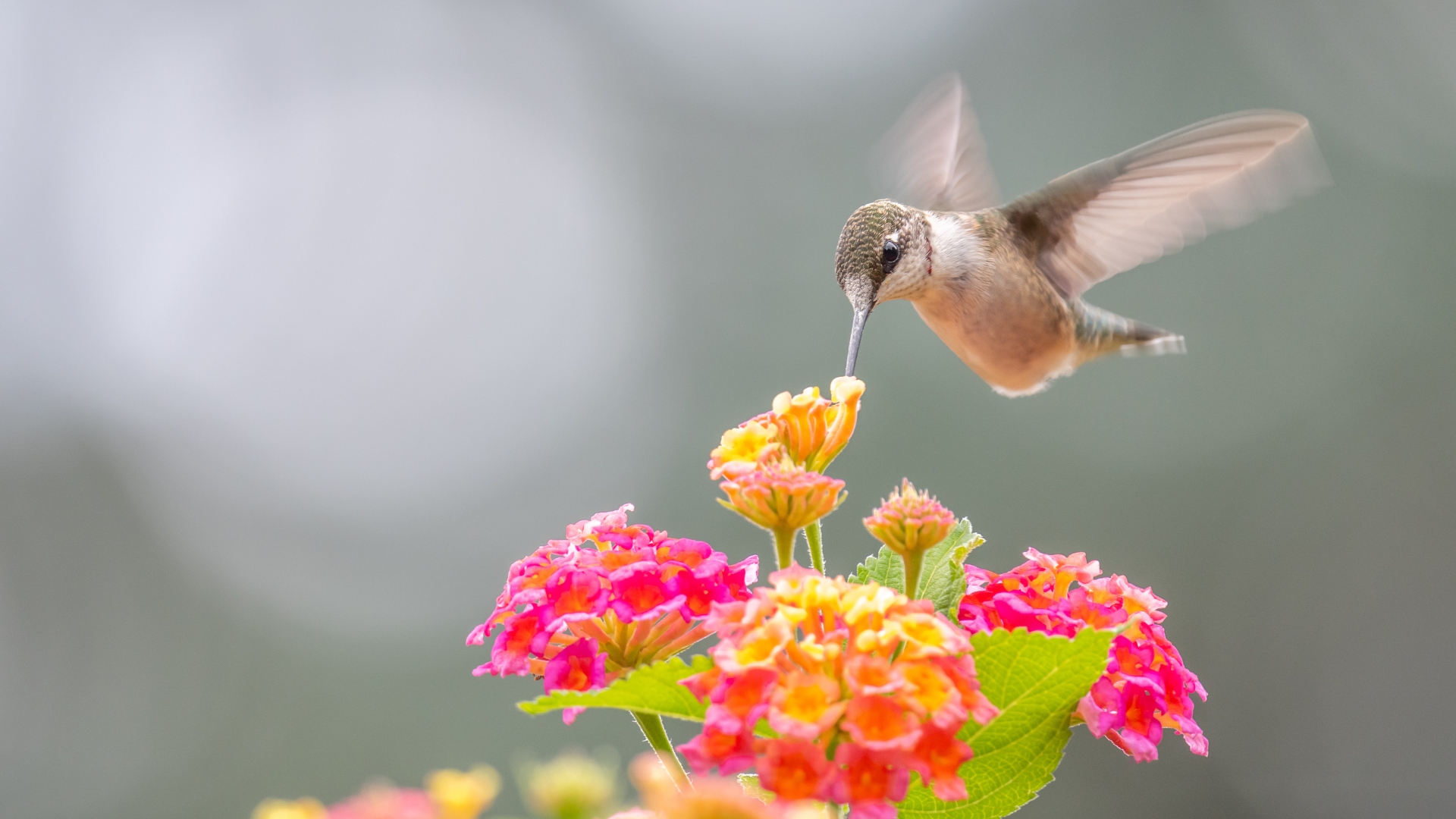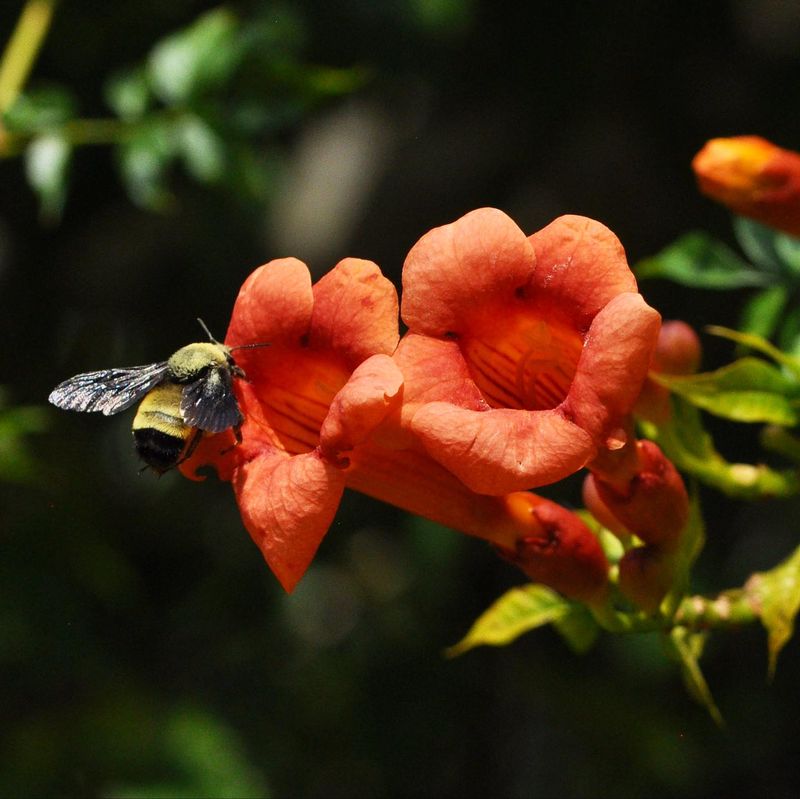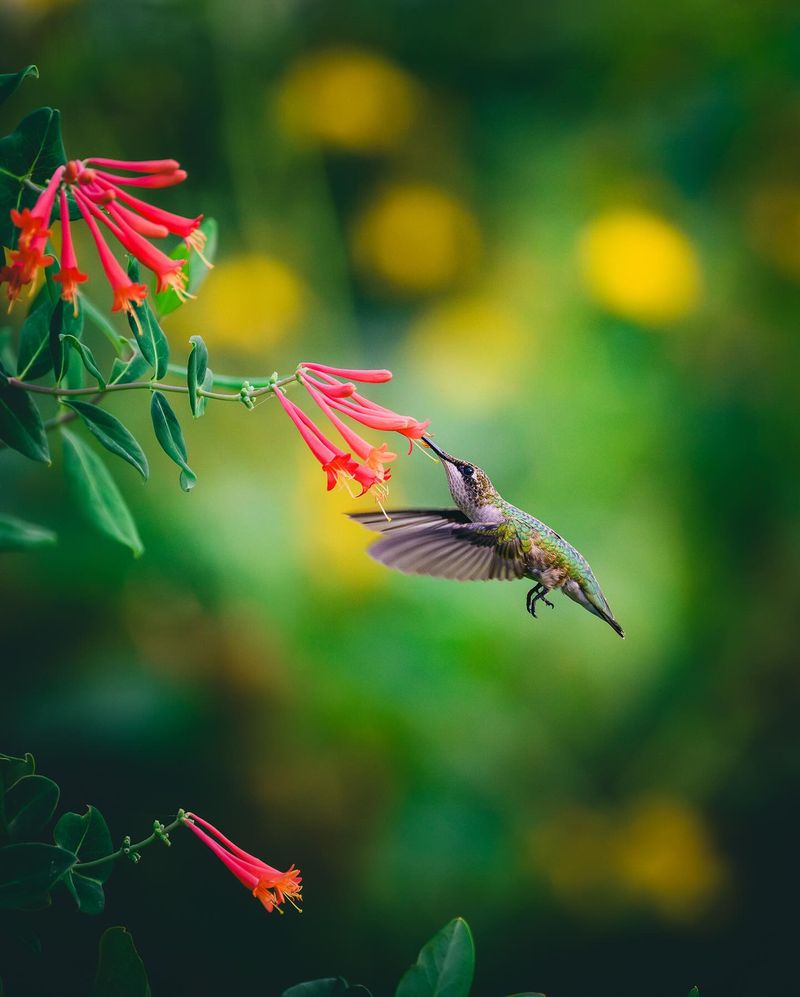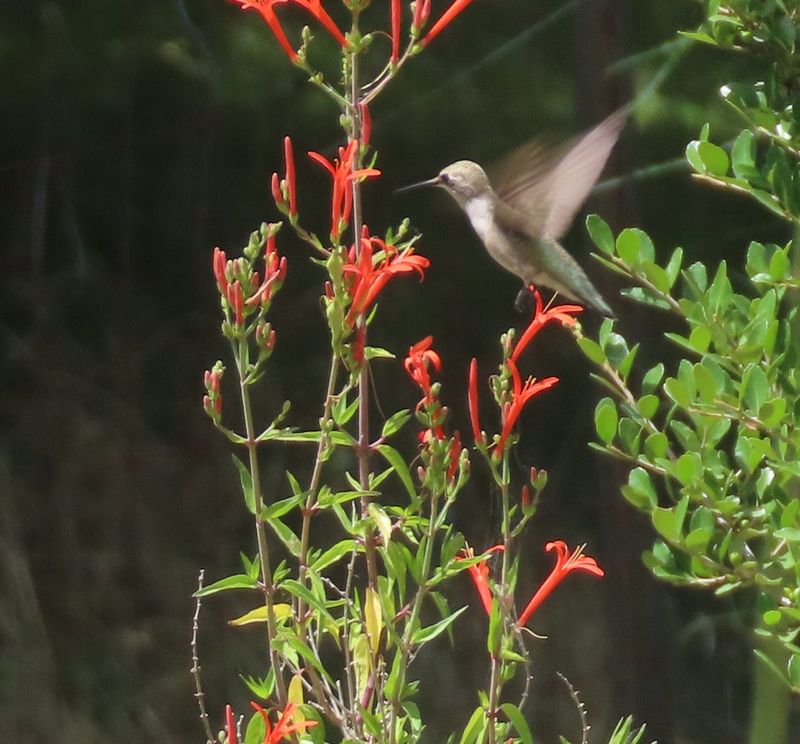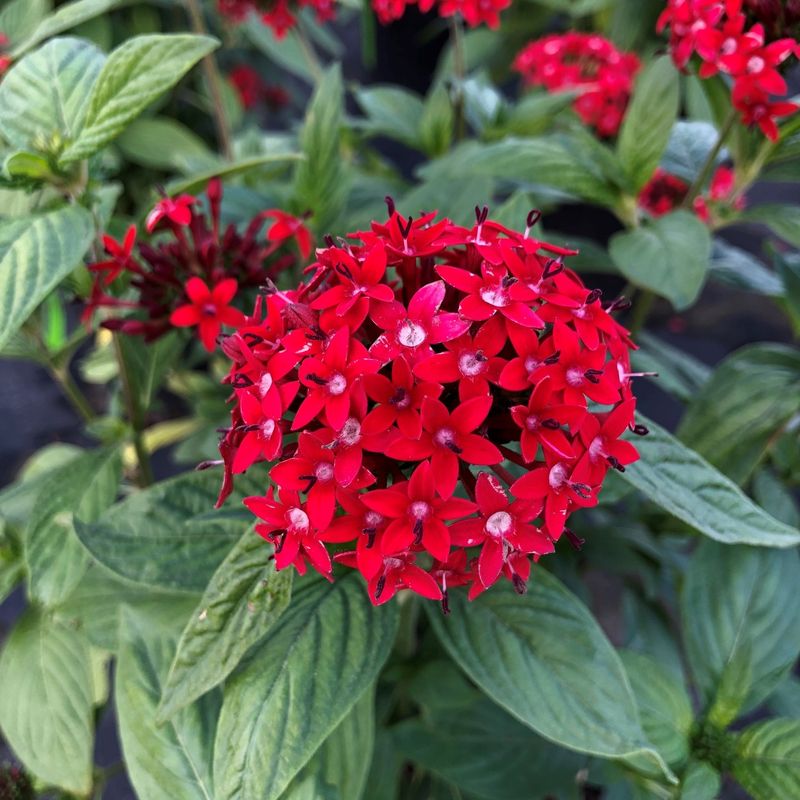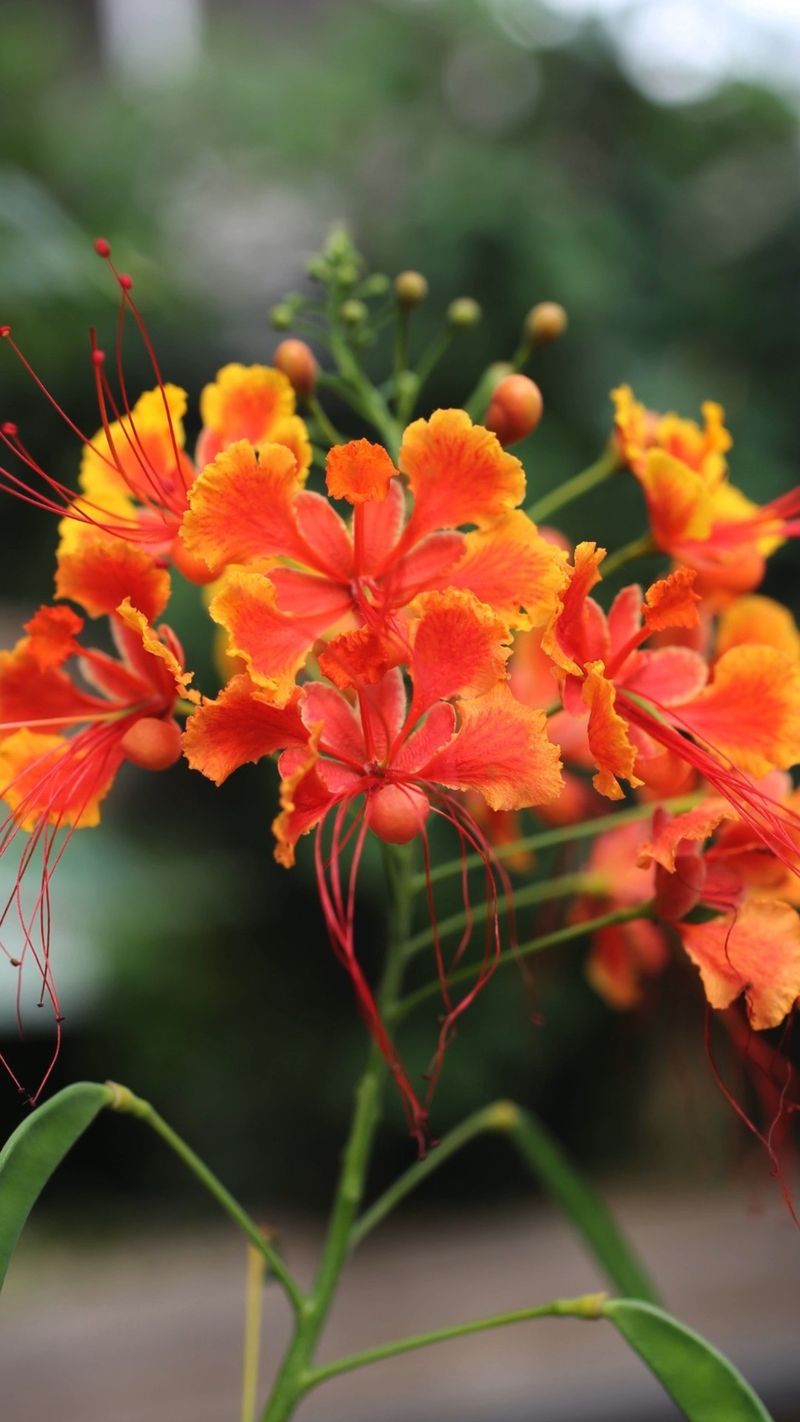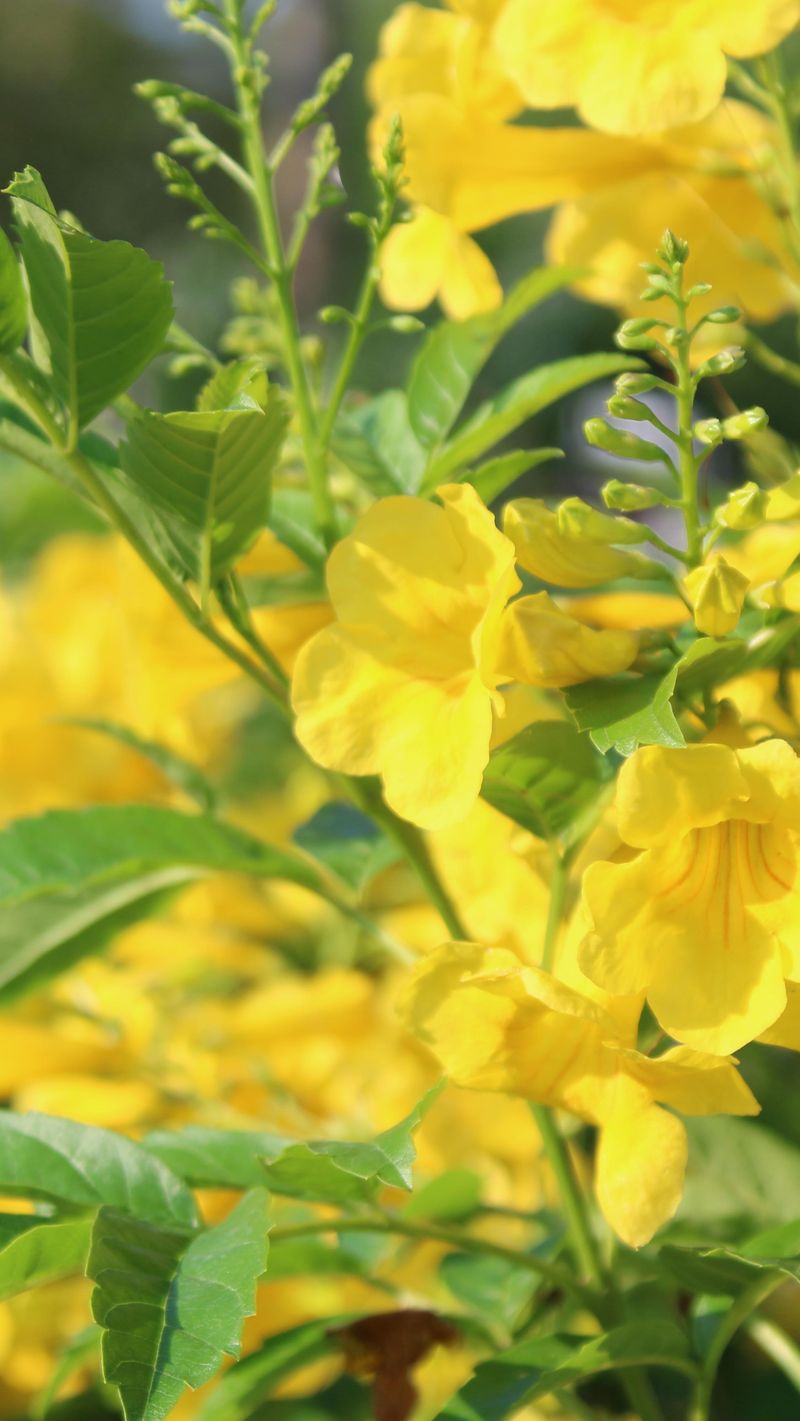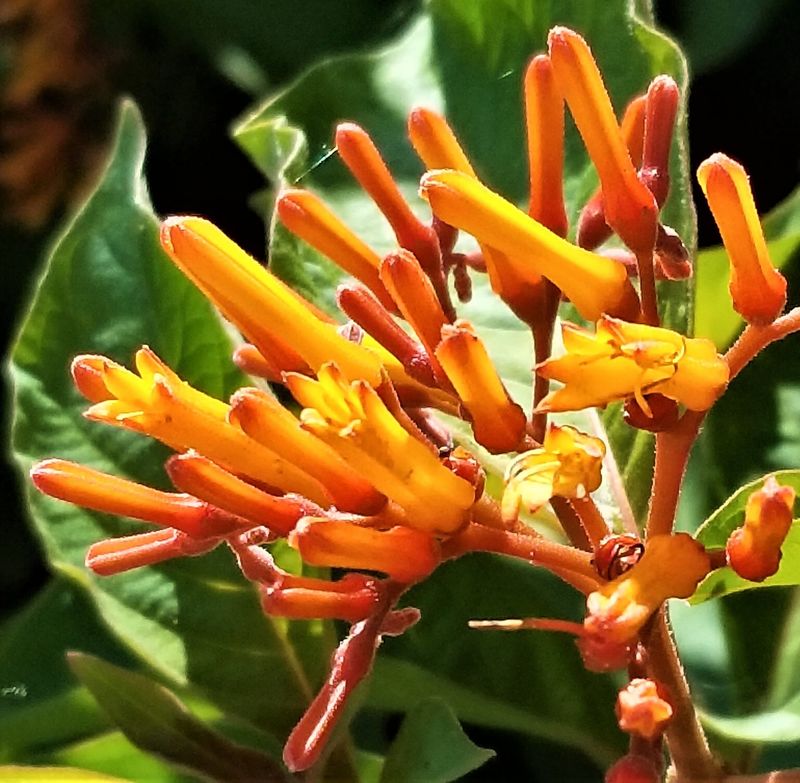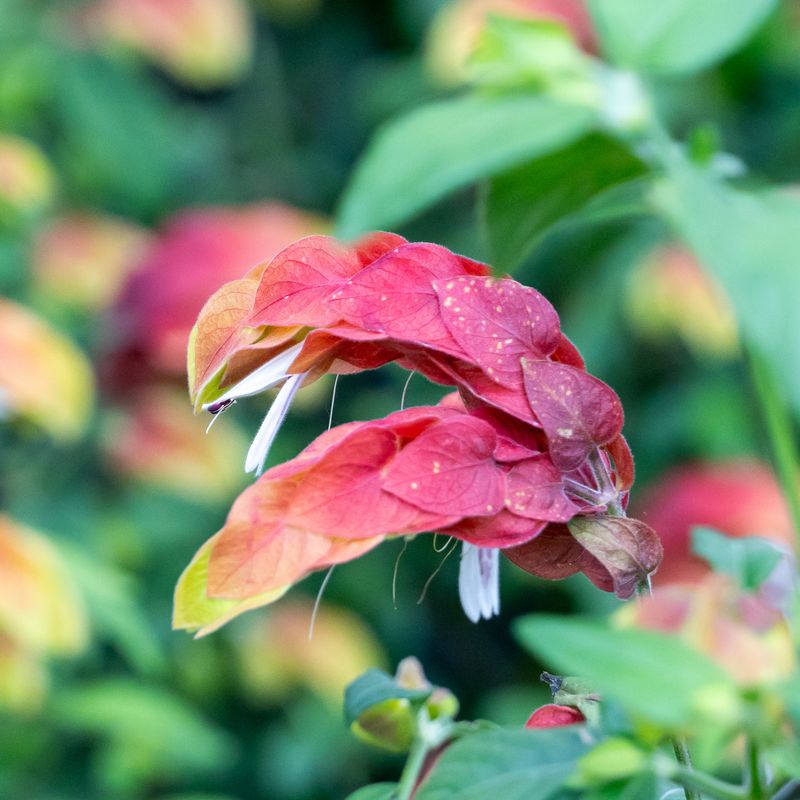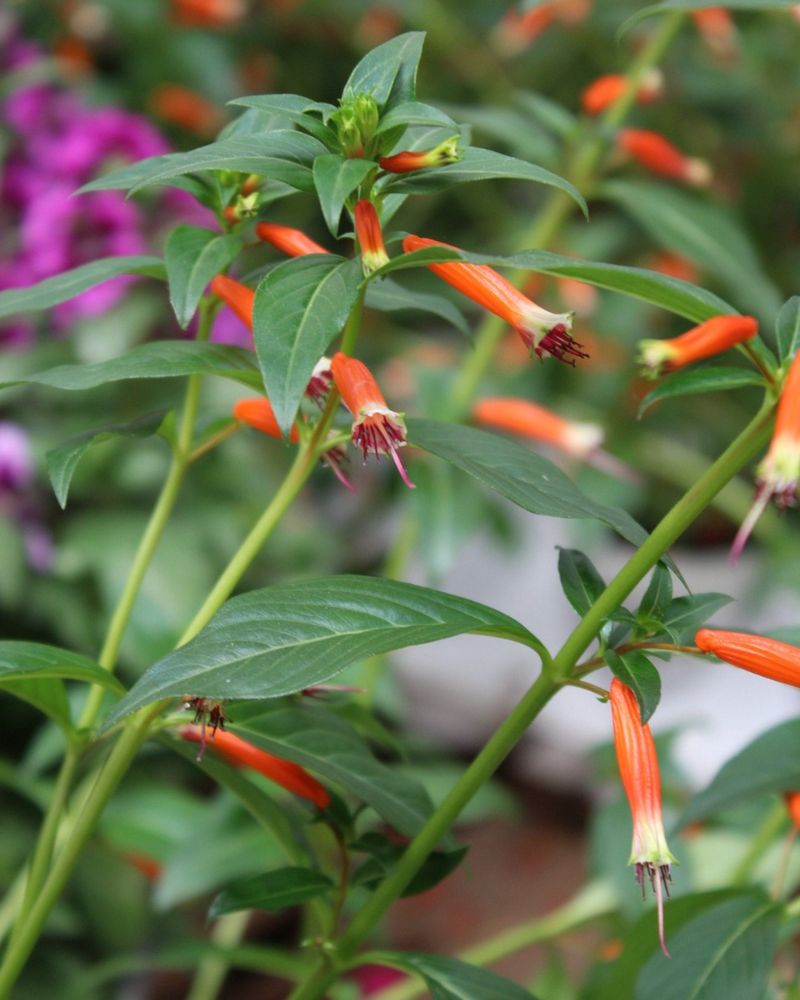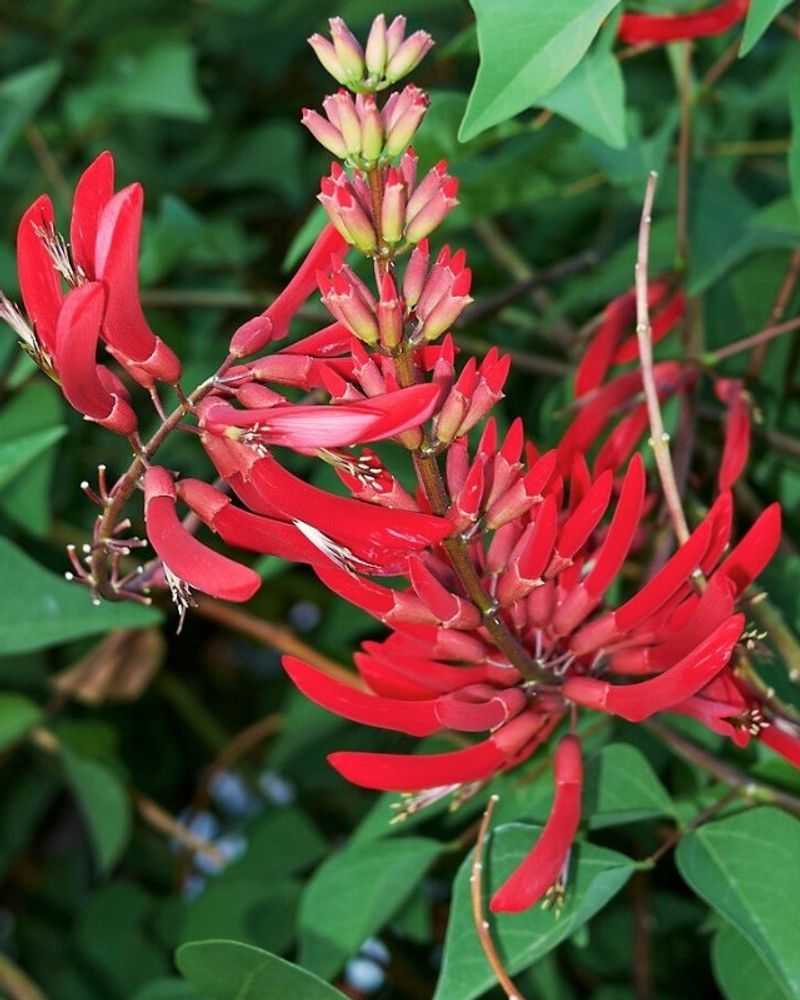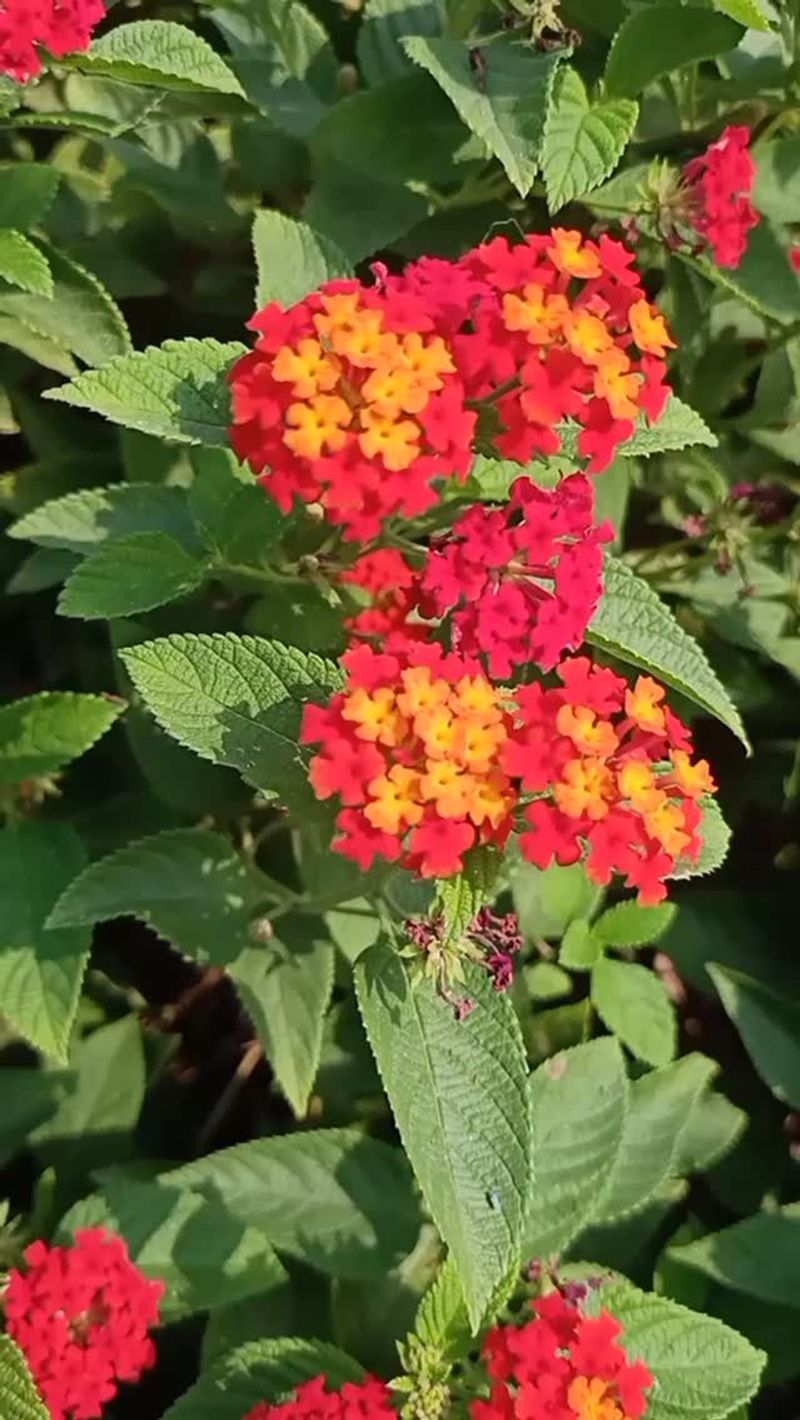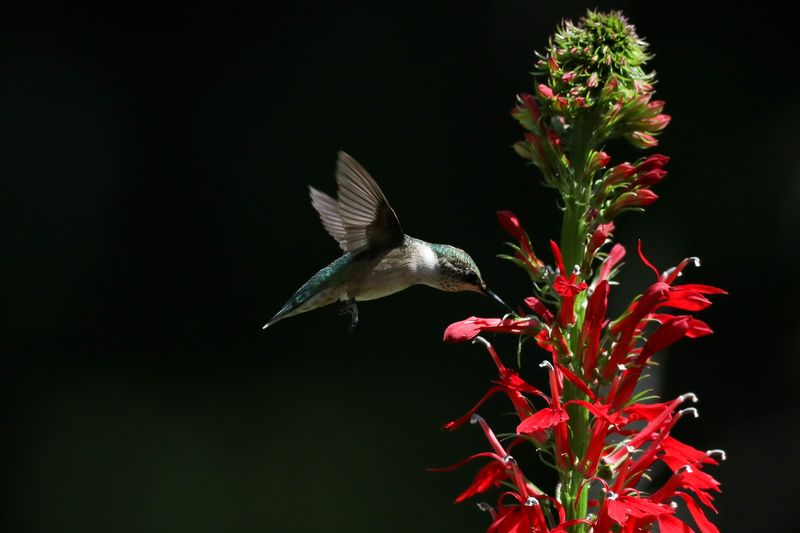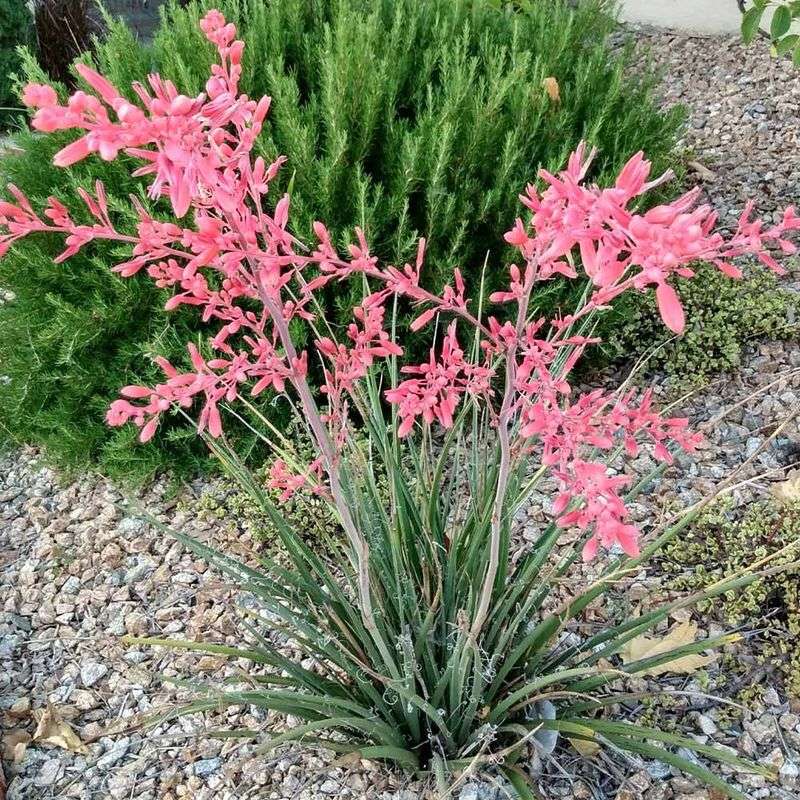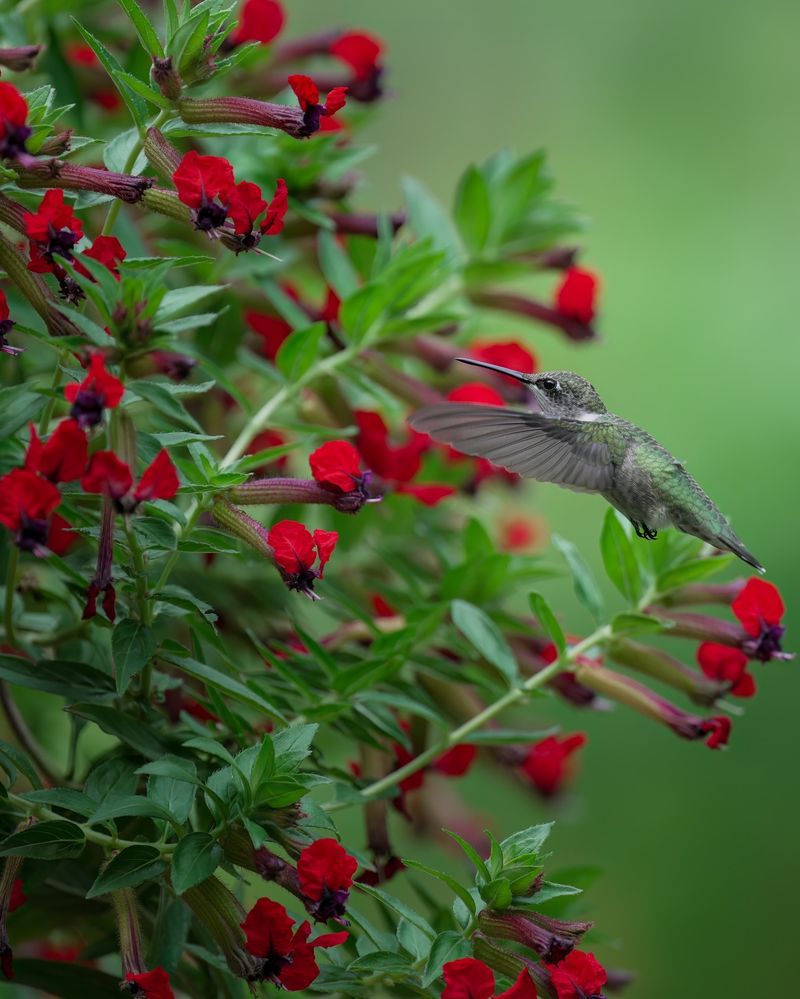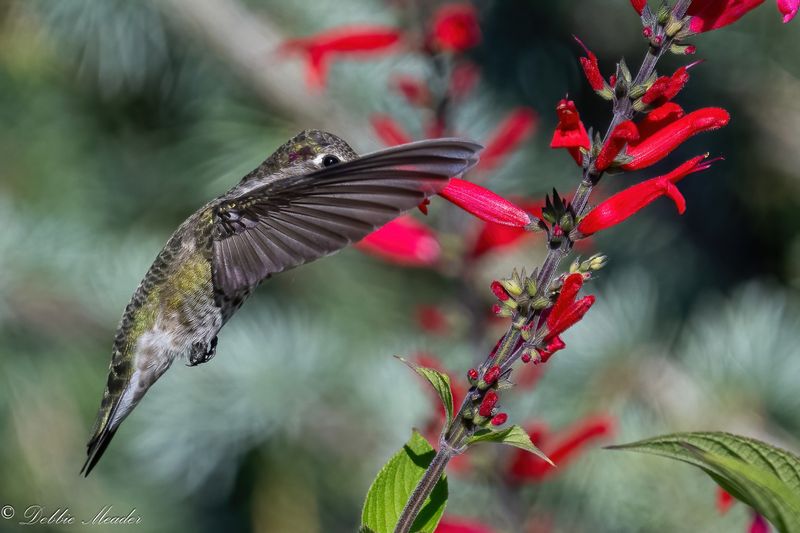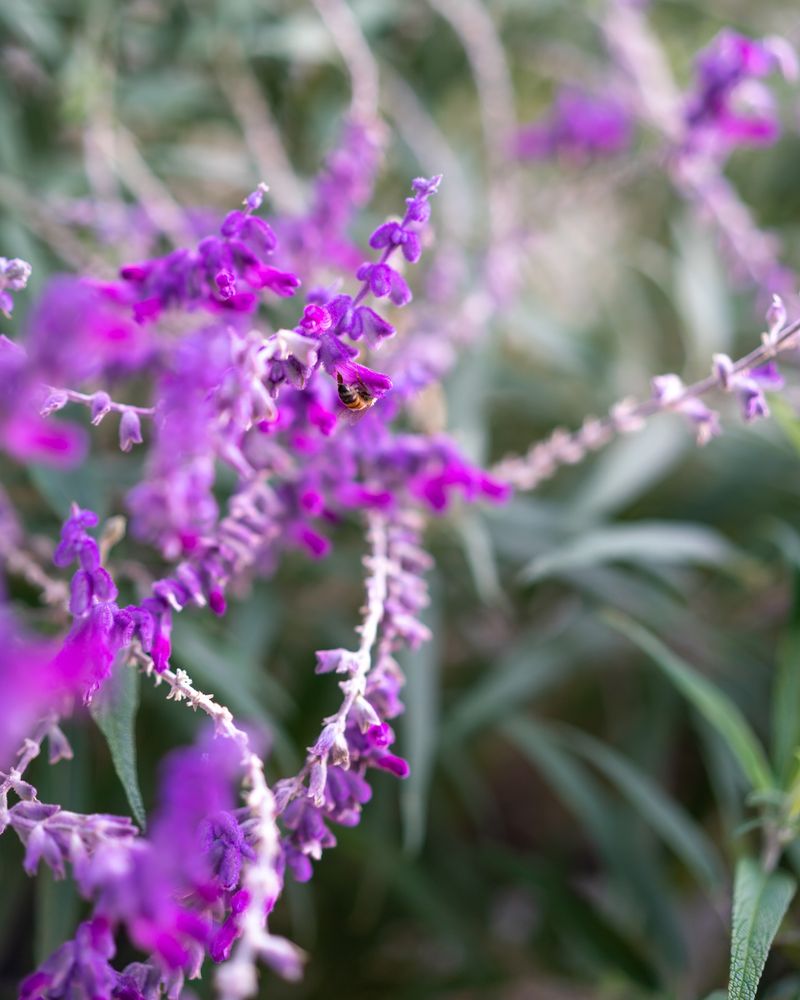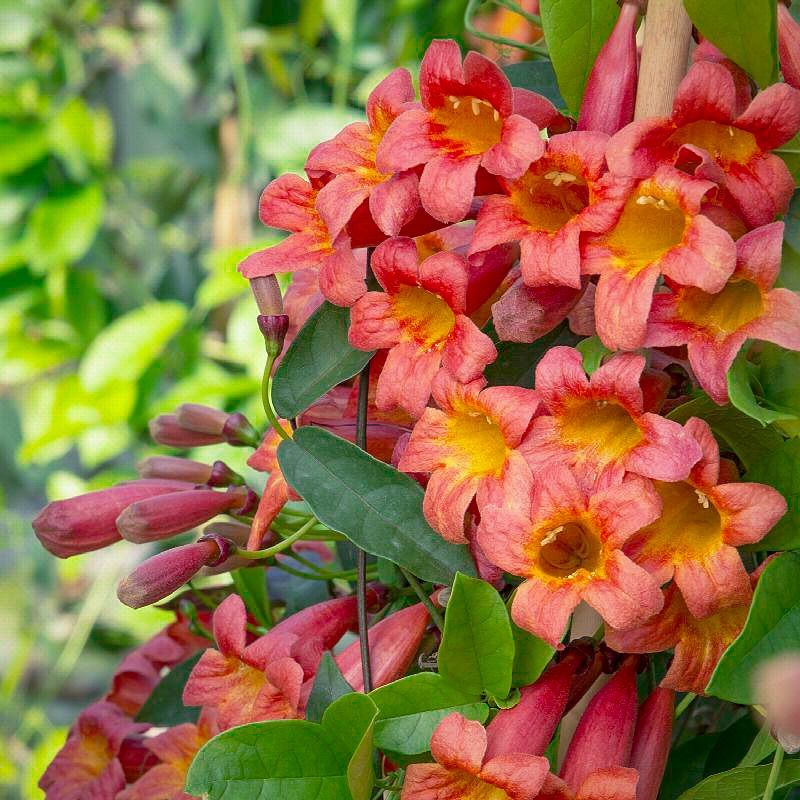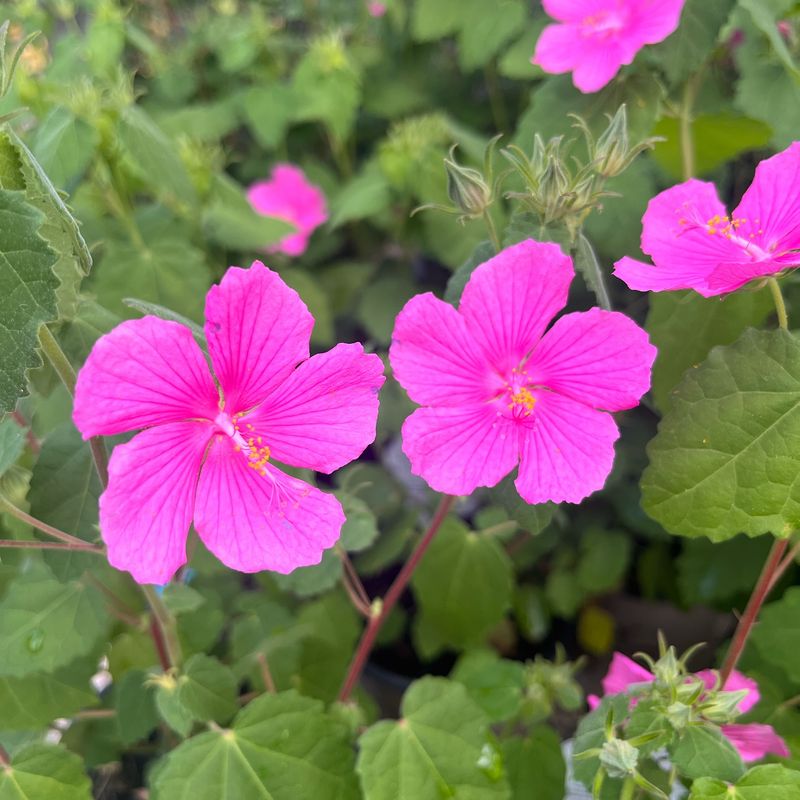Texas gardens and hummingbirds? A match made in flower-filled heaven. These 20 blooms are like magnets for those fast little fliers—and they bring so much energy and color with them.
I’ve rounded up the top picks that hummingbirds just can’t leave alone. Plus, I’ll share what makes each one so tempting to them. Get ready to turn your garden into their favorite hangout!
1. Trumpet Vine
The fiery orange-red blooms of this vigorous climber act like beacons for passing hummingbirds. Native to the eastern United States, this plant thrives in Texas heat and can grow up to 40 feet if not pruned regularly.
Hummers can’t resist the long, tubular flowers perfectly shaped for their specialized bills. Also called ‘cow-itch vine’ or ‘trumpet creeper,’ this plant needs sturdy support as it can become quite heavy. Expect multiple hummingbird visits throughout its long summer blooming period.
2. Coral Honeysuckle
Unlike its invasive Japanese cousin, this native vine offers tubular coral-red flowers that hummingbirds find irresistible. The nectar-rich blooms appear in spring and continue through fall in many Texas gardens, providing reliable food sources.
Grow this well-behaved climber on fences, trellises, or arbors where you can easily spot visiting hummers. Coral honeysuckle tolerates partial shade but flowers most abundantly in full sun. Its red berries later in the season attract other birds too, making it a wildlife garden superstar.
3. Turk’s Cap
A Texas native through and through, Turk’s Cap thrives even in shady spots where other hummingbird plants struggle. The unique red flowers never fully open, forming little turbans that perfectly accommodate a hummingbird’s beak and forehead.
Hardy and drought-resistant once established, this shrub requires minimal care while delivering maximum hummingbird attraction. The plant produces small edible fruits after flowering that resemble miniature apples. Many gardeners report hummingbirds developing a special preference for these twisted blooms.
4. Salvia Greggii
Commonly called autumn sage despite blooming nearly year-round in Texas, this perennial’s lipstick-red flowers (though varieties come in pink, purple, and white) are hummingbird magnets. The small but numerous tubular blooms contain the high-energy nectar these aerial acrobats crave.
Exceptionally drought-tolerant, this Texas native thrives in poor soil and baking sun where other plants surrender. Simply trim it back after heavy flowering periods to encourage fresh growth. Pollinators of all types love this plant, but hummingbirds seem to stake territorial claims around established specimens.
5. Flame Acanthus
Often called hummingbird bush for good reason, this Texas native produces fiery orange-red tubular flowers that seem custom-designed for hummingbird beaks. The blooms appear just when summer heat intensifies and many other plants take a break.
Remarkabl drought-tolerant once established, flame acanthus can handle the harshest Texas conditions while still attracting hummers. The woody shrub maintains a manageable 3-4 foot height, making it perfect for borders or wildlife gardens. Hard pruning in late winter encourages bushier growth and more flowers.
6. Pentas
Star-shaped clusters of tiny tubular flowers make pentas irresistible to hummingbirds despite not having the classic long, tubular shape. Available in red, pink, purple and white, the red varieties particularly draw hummingbird attention in Texas gardens.
Heat-loving and long-blooming, pentas provide reliable nectar sources from spring until frost. Their compact growth habit makes them perfect for containers near viewing windows where you can watch hummingbird visits. Deadheading spent blooms encourages continuous flowering throughout the season.
7. Pride of Barbados
Spectacular orange-red blooms with protruding stamens make this tropical showstopper unmissable in Texas landscapes. Hummingbirds zealously defend territories around these plants, returning multiple times daily to feed on the nectar-rich flowers.
Also called Mexican bird of paradise, this heat-loving plant thrives in the hottest parts of Texas. While considered a shrub, it can reach small tree proportions in frost-free areas. The feathery foliage adds textural interest even when not in bloom, though in Central and North Texas it may die back in winter.
8. Esperanza
Clusters of bright yellow bell-shaped flowers dangle from this Texas superstar plant all summer long. While yellow isn’t typically considered a primary hummingbird color, these nectar-rich blooms prove irresistible to the tiny fliers, especially during intense summer heat.
Drought-tolerant and pest-resistant, esperanza (also called yellow bells) thrives in the hottest, sunniest spots in Texas gardens. The plant grows quickly into a substantial shrub that can reach 6-8 feet in height. Some gardeners report hummingbirds actually preferring these yellow bells over nearby red flowers.
9. Firebush
Clusters of tubular red-orange flowers adorn this heat-loving shrub from summer until frost, providing crucial nectar during Texas’s hottest months. Hummingbirds frequently visit firebush multiple times daily, especially when other garden flowers have succumbed to the heat.
The plant’s reddish stems and new foliage add to its ornamental appeal while signaling to passing hummingbirds. In South Texas, firebush may grow as a perennial, while in Central and North Texas it’s often treated as an annual or container specimen. Few plants can match its flowering performance during triple-digit temperatures.
10. Shrimp Plant
Unusual overlapping bracts resembling pink shrimp create this plant’s signature look, with small white flowers peeking out between them. Though not the classic tubular shape, hummingbirds readily visit these flowers, probing between the bracts for hidden nectar.
Shrimp plants thrive in dappled shade, making them perfect for woodland garden edges in Texas landscapes. Both red and yellow varieties exist, with the red form typically attracting more hummingbirds. The nearly continuous bloom cycle from spring through fall ensures regular hummingbird visits.
11. Cigar Plant
Tubular orange-red flowers tipped with white and black resemble tiny lit cigars, creating an unusual visual appeal. Hummingbirds find these nectar-rich blooms particularly attractive, often hovering nearby even when not actively feeding.
This low-growing perennial works beautifully in hanging baskets or as border edging where the flowers can cascade over edges. In South Texas, cigar plants may bloom year-round, while in cooler regions they peak in summer and fall. The plant’s compact size makes it perfect for small spaces or containers near viewing windows.
12. Coral Bean
Dramatic spikes of tubular scarlet flowers appear in spring before the leaves emerge on this native Texas shrub. Hummingbirds returning from migration often make a beeline for these early-season nectar sources when few other options exist.
The plant later produces distinctive red bean pods that add visual interest but should never be eaten as they’re toxic. Coral bean can reach 6-10 feet in height in frost-free areas but typically dies back in winter in most of Texas. The early bloom time makes it especially valuable for supporting the first hummingbird arrivals of the season.
13. Texas Lantana
Clusters of tiny tubular flowers in orange, yellow, and red create miniature bouquets that hummingbirds visit repeatedly. Though each individual flower is small, the nectar rewards are substantial, making lantana a reliable hummingbird attractant throughout the growing season.
Incredibly heat and drought tolerant, Texas lantana survives conditions that wilt other plants. The aromatic foliage deters deer and other browsers but doesn’t bother hummingbirds a bit. For maximum hummingbird attraction, choose varieties with red or orange in their color scheme rather than pure yellow or white forms.
14. Cardinal Flower
Intense scarlet spikes of tubular flowers make cardinal flower perhaps the most dramatic hummingbird plant for partially shaded spots. Native to moist areas across Texas, these stunning perennials create a vertical accent while providing rich nectar rewards.
Unlike many hummingbird plants, cardinal flower appreciates consistent moisture and some afternoon shade in hot Texas summers. The brilliant red color signals to passing hummingbirds from considerable distances. Plant these near water features or in areas that stay naturally moist for best results.
15. Red Yucca
Despite its name, this Texas native isn’t a true yucca but produces spectacular 5-foot stalks of tubular coral flowers that hummingbirds can’t resist. The blooms appear in late spring and continue sporadically through summer, drawing hummingbirds with their abundant nectar.
Exceptionally drought-tolerant, red yucca thrives in rocky, poor soil where little else will grow. The evergreen, grass-like foliage provides year-round structure in the landscape. Multiple bloom stalks rise from established plants, creating dramatic vertical elements that serve as hummingbird feeding stations.
16. Bat-faced Cuphea
Whimsical purple and red flowers resembling tiny bat faces might seem novelty plants, but hummingbirds take them very seriously. The unusual blooms contain sweet nectar that keeps hummers coming back throughout the growing season.
This low-growing perennial forms a compact mound about 18-24 inches tall and wide. Heat-tolerant and long-blooming, bat-faced cuphea performs reliably even during Texas summer extremes. The quirky flowers appear continuously from spring until frost, ensuring steady hummingbird visits.
17. Pineapple Sage
Vivid scarlet tubular flowers appear in fall just when hummingbirds need extra energy for migration. The timing couldn’t be better, as many other nectar sources diminish while pineapple sage reaches peak bloom in autumn Texas gardens.
Beyond its hummingbird appeal, the crushed leaves emit a delightful pineapple scent that adds sensory pleasure to the garden. This perennial sage grows 3-4 feet tall and wide in a single season. The late bloom period makes it especially valuable for supporting the final hummingbird generations before they head south.
18. Mexican Bush Sage
Velvety purple flower spikes create a dramatic late-season display that hummingbirds find irresistible. Though not red, these fuzzy blooms contain rich nectar reserves that support hummingbirds during fall migration through Texas.
The silvery foliage provides attractive contrast in the garden even before flowering begins. Mexican bush sage typically reaches 3-4 feet in height and width, creating an impressive presence. The plant’s late bloom cycle (September through frost) fills an important gap when many summer flowers have finished.
19. Crossvine
Trumpet-shaped orange-red blooms cover this vigorous native vine in spring, creating a spectacular display that coincides with hummingbird migration. The tubular flowers contain exactly the high-energy nectar these tiny birds need after their long journey north.
Evergreen in most of Texas, crossvine climbs trees or structures using adhesive discs rather than twining. Once established, it tolerates drought and poor soil with remarkable resilience. A second, lighter bloom period often occurs in fall, providing additional hummingbird support during southward migration.
20. Rock Rose
Delicate pink flowers resembling miniature hibiscus open daily on this drought-tough Texas native. Though each bloom lasts just one day, the plant produces new flowers continuously from spring through fall, ensuring steady hummingbird visits.
Rock rose thrives in the poorest, driest soils where many plants struggle. The gray-green foliage creates an attractive backdrop for the bright flowers. Hummingbirds particularly appreciate this plant during summer heat when it continues flowering while other garden plants may take a break.

